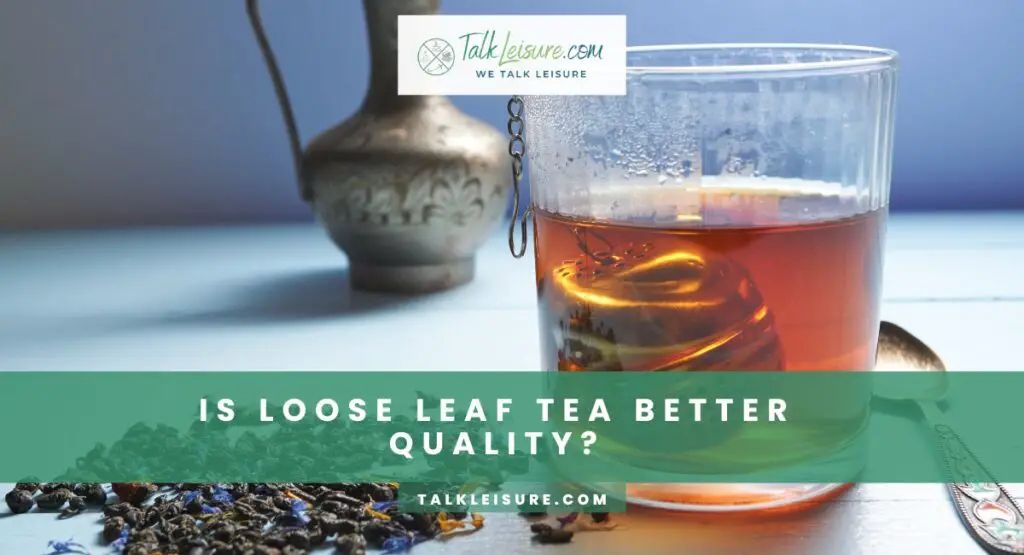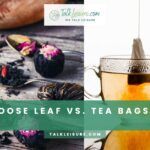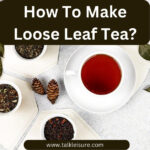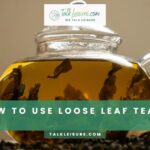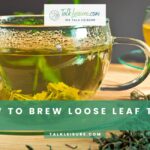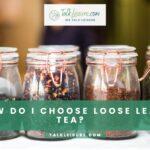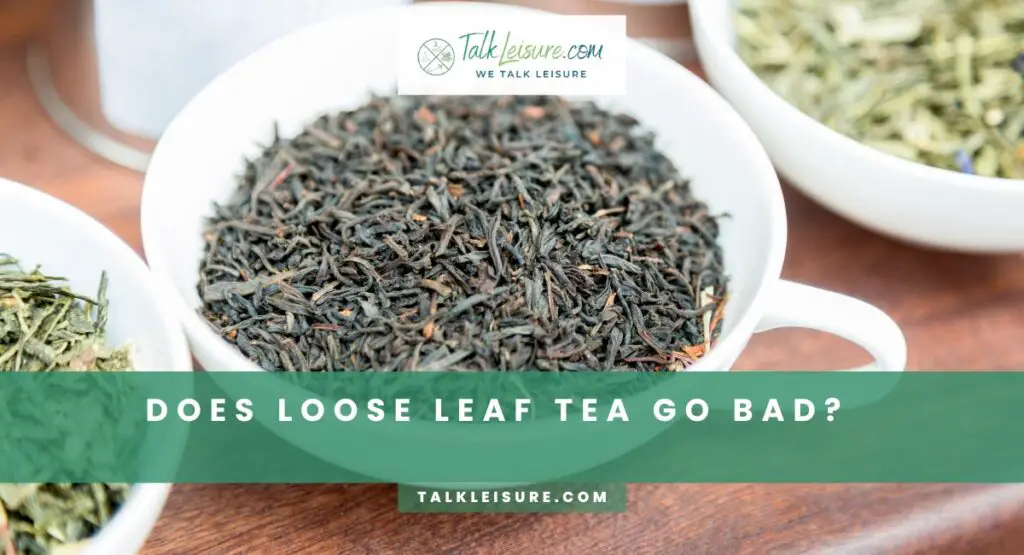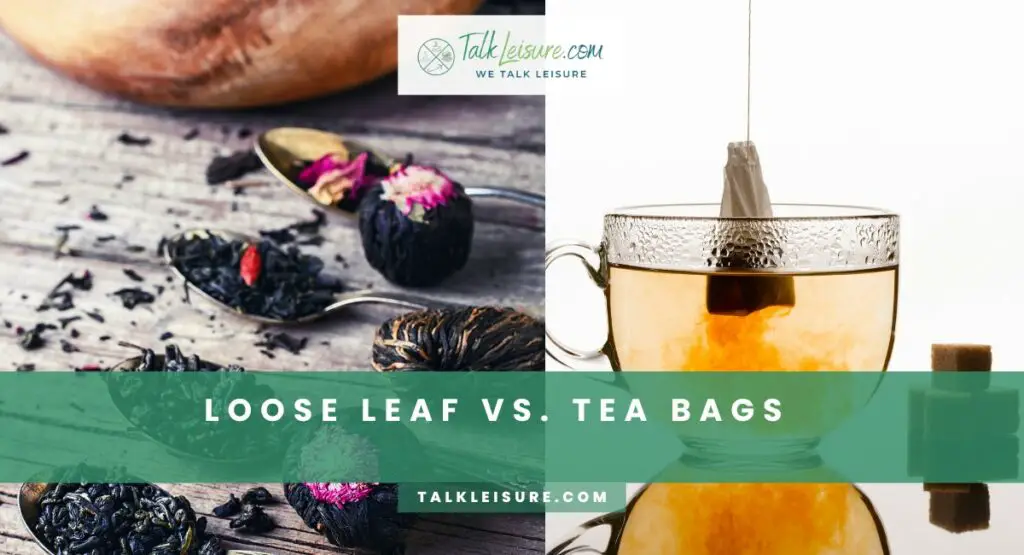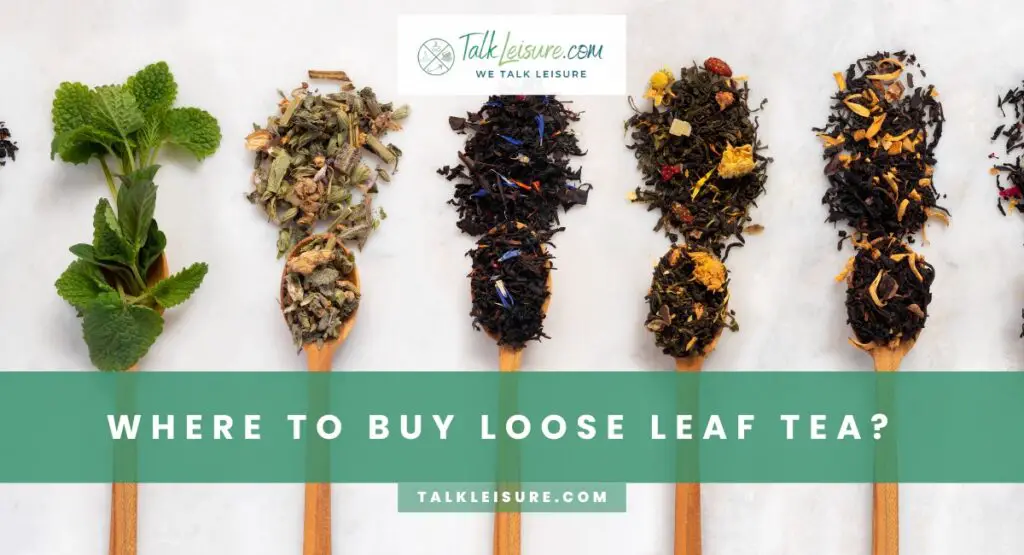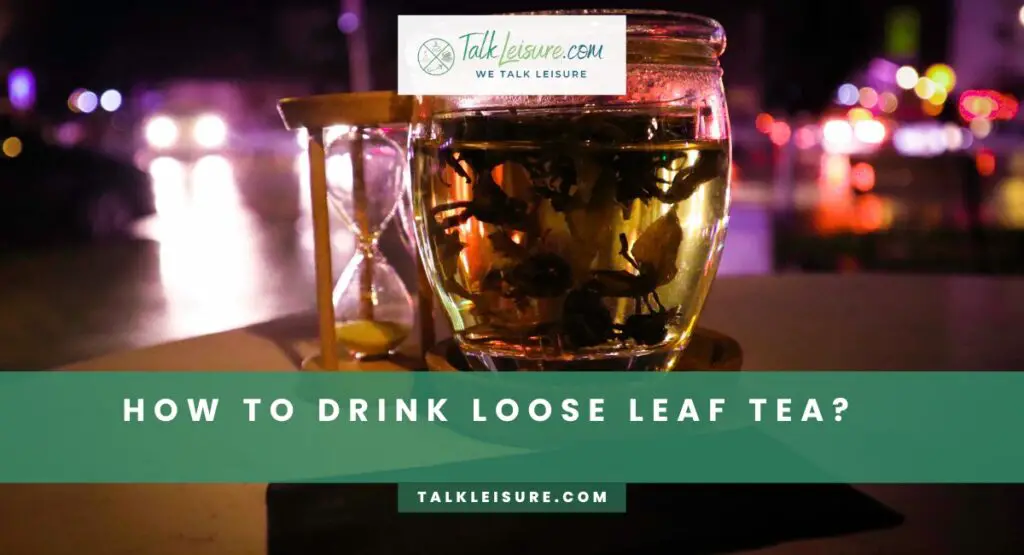In a world where convenience often takes center stage, the timeless tradition of tea consumption has evolved to accommodate our fast-paced lifestyles.
However, a conundrum persists: is loose-leaf tea truly superior in quality to its bagged counterparts?
Yes, loose-leaf tea is generally considered better quality than tea bags. Loose-leaf tea consists of whole, unbroken leaves, preserving flavor and aroma better than the finer, lower-grade tea in most tea bags.
This article aims to explore the nuances of loose-leaf tea, decipher its quality, health benefits, environmental impact, and why it remains the choice of discerning tea enthusiasts.
What Is Loose Leaf Tea?
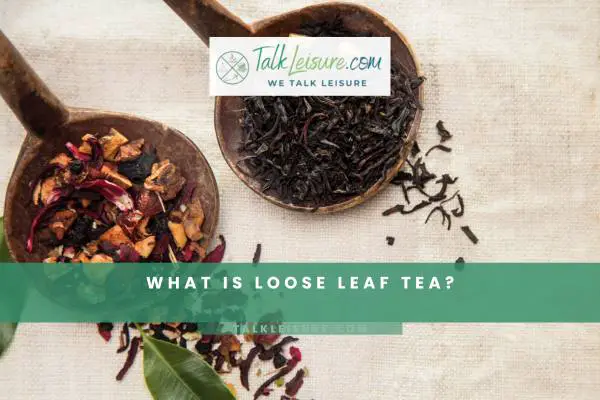
Loose-leaf tea, as the name suggests, consists of whole or partially broken tea leaves not enclosed within the confines of a tea bag.
Retaining whole leaves is pivotal in the taste, aroma, and tea experience.
Loose-leaf tea refers to high-quality tea leaves sold in unbroken, whole form instead of pre-packaged tea bags.
This type of tea offers a more authentic and flavorful experience than tea bags, as the leaves have more room to expand during steeping.
Loose-leaf tea is often harvested with greater care, ensuring the preservation of essential oils and flavors.
To brew loose-leaf tea, one typically uses a tea infuser or a teapot with an integrated strainer, allowing the leaves to unfurl and release their full aroma and taste.
This method provides greater control over the brewing process, enabling tea enthusiasts to experiment with different water temperatures, steeping times, and tea-to-water ratios to achieve the desired strength and flavor profile.
Loose-leaf tea comes in various types, including black, green, oolong, and herbal, offering a delightful journey for those seeking a richer and more customizable tea-drinking experience.
What To Look For When Buying Teas?
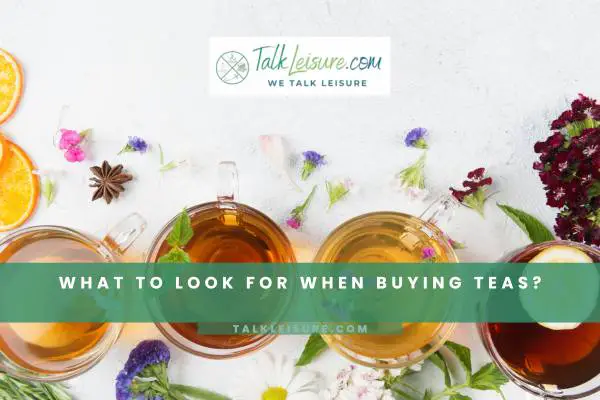
Before embarking on the journey to find the perfect cup of tea, it’s essential to understand what distinguishes premium loose-leaf tea from the rest. When buying loose-leaf tea, consider the following factors:
1. Origin: The geographical origin of the tea leaves significantly impacts their flavor profile. Different regions yield distinct taste characteristics due to variations in climate, altitude, and soil conditions.
2. Leaf Appearance: High-quality loose-leaf tea is recognizable by its whole or partially unbroken leaves. These leaves unfurl during steeping, releasing a symphony of flavors and aromas.
3. Aroma: Aromatic notes are a hallmark of quality tea. Delicately fragrant loose-leaf teas offer a sensory experience that transcends the mundane.
4. Color: The color of the brewed tea can provide insights into its quality. For example, black teas produce a deep, rich hue, while green teas are known for their pale, light color.
5. Texture: Quality tea leaves have a certain texture—smooth, supple, and often velvety to the touch.
6. Certifications: Look for certifications like “organic” or “fair trade,” which reflect a commitment to quality and sustainability.
How To Choose Quality Loose Leaf Tea?

The quest for quality loose-leaf tea involves both art and science. To ensure you’re making an informed choice, consider the following steps:
1. Buy from Reputable Sources: Choose established tea purveyors with a reputation for quality. They are more likely to source their tea leaves from reliable growers.
2. Read Reviews: Online platforms provide a wealth of information through customer reviews. These can offer insights into a tea’s taste, aroma, and overall experience.
3. Inspect the Leaves: Examine the appearance of the leaves. Avoid tea that appears overly fragmented or contains an excessive amount of stems.
4. Scent Test: Gently inhale the aroma of the tea leaves. A rich, enticing fragrance usually indicates freshness.
5. Ask for Recommendations: Don’t hesitate to ask tea enthusiasts or experts for recommendations. Their insights can be invaluable.
Is Loose Leaf Tea Higher Quality?
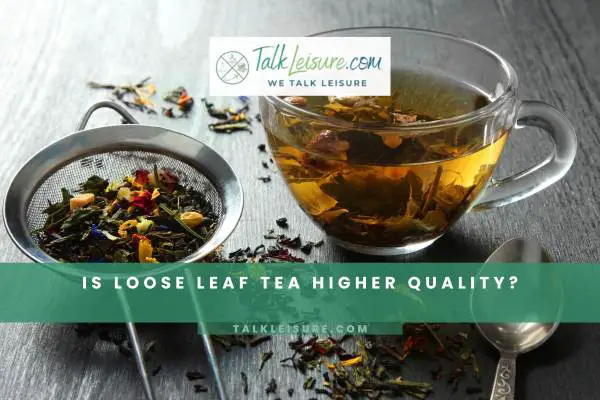
The debate surrounding loose-leaf tea’s quality vis-à-vis tea bags has spanned generations.
The answer is in the leaves themselves. Loose-leaf tea is better because its whole leaves can make higher-quality tea. These leaves are less likely to get damaged and changed by air and time.
Loose-leaf tea is often considered to be of higher quality compared to tea bags.
This is because loose-leaf tea consists of whole, unbroken tea leaves, while tea bags usually contain smaller, broken tea leaves or fannings.
Whole leaves retain more essential oils, flavors, and aromas, which can result in a richer and more nuanced tea experience.
Loose-leaf tea also allows more room for the leaves to expand during steeping, leading to a better infusion and flavor extraction.
Additionally, loose-leaf teas are commonly sourced from higher-grade tea leaves, which tend to be carefully processed and handpicked.
This attention to detail contributes to a more authentic and enjoyable tea-drinking encounter.
While loose-leaf tea might require more effort in preparation, its elevated quality and superior taste make it a popular choice among enthusiasts.
What Are The Best Loose Leaf Teas?
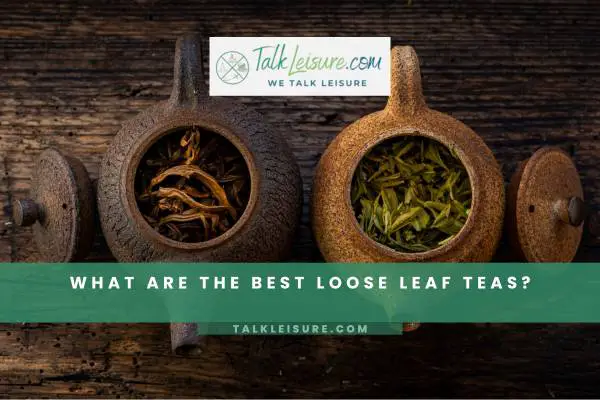
The world of loose-leaf tea is vast and diverse, offering an array of flavors and aromas that cater to every palate. Some of the best-loved loose-leaf teas include:
1. Darjeeling: Known as the “Champagne of Teas,” Darjeeling offers a delicate and floral experience.
2. Assam: A robust and malty black tea with a hearty character, perfect for a strong cup.
3. Sencha: A classic Japanese green tea, sencha boasts grassy and slightly sweet notes.
4. Oolong: This partially oxidized tea falls between black and green tea, offering diverse flavors from fruity to nutty.
5. White Peony: A gentle, refreshing white tea with a subtle, nuanced flavor profile.
Is Loose Leaf Tea Better Quality?
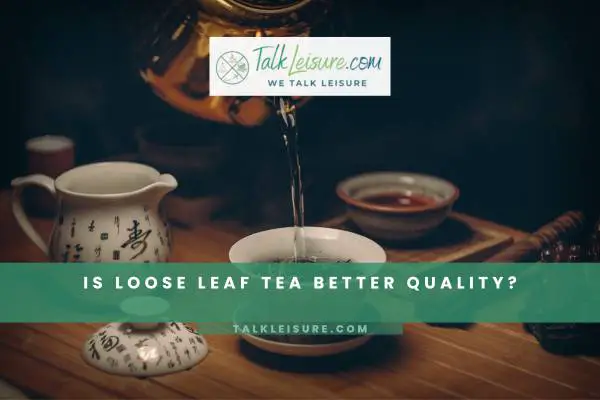
Loose-leaf tea is often considered to be better quality than tea bags.
This is because loose-leaf tea consists of whole, unbroken tea leaves that retain more of their natural oils, flavors, and aroma.
In contrast, tea bags often contain lower-grade tea fannings or dust, resulting in a less flavorful and aromatic brew.
Loose-leaf tea also allows more room for the leaves to unfurl and expand during steeping, leading to a more robust and well-balanced flavor profile.
Also, loose-leaf tea allows you to customize the amount of tea you use, resulting in a stronger or milder brew according to your preference.
While loose-leaf tea might require a bit more effort in terms of preparation, the superior quality and taste make it a popular choice among tea enthusiasts.
Why Loose Leaf Tea Is Better?
Loose-leaf tea is a superior choice for a few simple yet compelling reasons.
First, loose-leaf tea consists of whole, unbroken leaves that retain more natural flavors and essential oils than tea bags, which often contain broken and dusty bits.
This results in a richer, more flavorful cup of tea.
Second, loose-leaf tea allows for more customization in terms of tea strength. You can adjust the amount of tea leaves you use, tailoring it to your preference, whereas tea bags usually come in standardized portions.
Also, loose-leaf tea is more environmentally friendly, generating less waste than individually packaged tea bags.
Lastly, exploring loose-leaf tea can be an enjoyable experience, offering various tea types and blends to discover and savor.
How To Tell Loose Leaf Tea Better Quality?
Distinguishing high-quality loose-leaf tea requires a keen eye and a refined palate. Here’s how you can discern better quality:
1. Leaf Appearance: Whole or partially unbroken leaves indicate better quality.
2. Aroma: Fresh, fragrant, and distinct aromas indicate superior quality.
3. Color: The brewed tea should be vibrant and consistent.
4. Flavor Complexity: A good quality loose-leaf tea offers multiple layers of flavor that evolve as you sip.
5. Smooth Texture: The texture of the brewed tea should be smooth and devoid of bitterness.
Is Loose Leaf Tea Healthier?
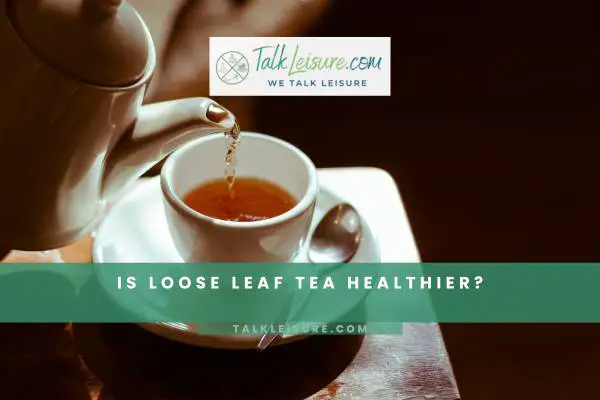
Loose-leaf tea can be healthier than tea bags because it’s usually less processed and contains larger, whole leaves.
This can retain more natural antioxidants and flavors.
However, the healthiness also depends on the tea type and how you brew it.
Loose-leaf tea offers more control over quality, but both loose-leaf and tea bags can provide health benefits. Choosing high-quality tea and brewing it properly is important for the best health advantages.
Tea Bags Vs. Loose Leaf Tea Health Benefits
While tea bags and loose-leaf tea have their merits, they tend to retain more health benefits due to the intact leaves. Tea bags, especially those containing smaller particles, may release fewer antioxidants and other beneficial compounds during brewing.
Here’s a comparison table outlining the health benefits of tea bags vs. loose-leaf tea:
| Aspect | Tea Bags | Loose Leaf Tea |
|---|---|---|
| Quality of Tea | Often contains lower quality, broken tea leaves | Generally higher quality whole or large tea leaves |
| Flavor and Aroma | Often contains lower-quality, broken tea leaves | Offers richer, more complex flavor and aroma |
| Health Benefits | May contain fewer antioxidants and nutrients | Retains more antioxidants and nutrients |
| Brewing Convenience | Convenient and quick to brew | Requires more time and equipment for brewing |
| Environmental Impact | Typically packaged in individual wrappers | Generally produces less waste due to less packaging |
| Customization | Limited control over tea strength and blend | Can control the amount and blend for customization |
| Price | Often more affordable | Can be more expensive depending on quality |
| Variety | Limited variety in flavors and blends | Wide range of flavors, blends, and tea types |
| Sustainability | Generally less sustainable due to packaging waste | Potentially more sustainable with reusable options |
| Storage | Longer shelf life due to sealed packaging | Needs proper storage to maintain freshness |
Is Loose Leaf Tea Better Than Bagged?
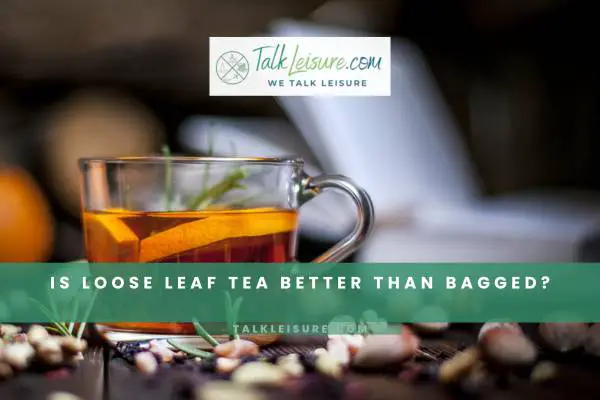
Loose-leaf tea is generally better than bagged tea due to its higher quality and superior flavor. The intact leaves in loose-leaf tea provide a more authentic taste and aroma, while tea bags sometimes result in a weaker brew.
So, Loose-leaf tea is generally considered better than bagged tea.
This is because loose-leaf tea comprises whole tea leaves that can expand fully during steeping, releasing more flavor and aroma.
Bagged tea, on the other hand, often contains broken tea leaves or fannings, leading to a weaker taste.
Loose-leaf tea also tends to be of higher quality, as it is less processed and retains more of its natural oils and flavors.
Additionally, loose-leaf tea allows you to control the amount of tea you use, resulting in a more customizable and satisfying brew.
While bagged tea is convenient, especially for on-the-go situations, loose-leaf tea is the way to go if you’re looking for a richer and more authentic experience.
Taste And Health Differences
The taste and health differences between loose-leaf tea and bagged tea are closely intertwined.
Loose-leaf tea’s superior flavor comes from the intact leaves, contributing to its higher concentration of health-enhancing compounds.
Here’s a table of the Taste and Health Differences between loose-leaf tea and tea bags:
| Aspect | Loose Leaf Tea | Tea Bags |
|---|---|---|
| Taste | Generally considered to have richer, more | May lack complexity and subtlety due to smaller |
| complex flavors due to larger tea leaves that | tea particles and limited space for expansion. | |
| can unfurl and release their flavors fully. | ||
| Quality | Steeping. | May use lower quality tea leaves and |
| whole or larger tea leaves, providing a more | fannings (small broken tea leaves) for faster | |
| Processing and larger leaf size. | Authentic and flavorful experience. | |
| Health Benefits | Can retain more beneficial compounds like | It may lack complexity and subtlety due to being smaller. |
| antioxidants and polyphenols due to less | It may lack complexity and subtlety due to being smaller. | |
| It may lack complexity and subtlety due to smaller. | ||
| Brewing Time | For flavors to fully develop. | Infuses faster due to smaller tea particles and |
| It may require extra tools like infusers or | In situations with time constraints. | |
| Convenience | Teapots for steeping. | We have increased surface area. |
| They have increased surface area. | Ratio and steeping conditions. | |
| Environmental Impact | Often more environmentally friendly as they | Can generate more waste due to individual |
| produce less waste (no individual packaging) | packaging for each tea bag. | |
| Customization | Allows for more control over tea-to-water | Limited in customization as pre-portioned tea |
| Bags might not suit all preferences. | It may lack the visual appeal of whole tea leaves | |
| Aesthetic Experience | Often appreciated by tea enthusiasts for the | Unfurling during steeping. |
| The aesthetic beauty of unfurling leaves. | The aesthetic beauty of unfurling leaves. | |
| Price | Generally, higher quality loose leaf teas | Often more affordable due to the use of smaller |
| And lower-grade tea leaves. | Due to larger leaf size. | |
| Storage | Can be more sensitive to storage conditions | To store due to its compressed form. |
| Due to the larger leaf size. | to store due to its compressed form. |
Why Do People Prefer Loose Leaf Tea?
Loose-leaf tea has gained popularity due to its superior quality and customizable brewing experience.
Unlike pre-packaged tea bags, loose-leaf tea consists of whole or larger tea leaves, preserving their essential oils, flavor compounds, and aromas.
This results in a richer and more nuanced taste profile that tea enthusiasts appreciate.
Additionally, loose-leaf tea offers greater flexibility in terms of portion size, allowing individuals to adjust the strength of their brew according to personal preferences.
The ritual of preparing loose-leaf tea, from measuring the leaves to steeping them in a tea infuser, can be a meditative and sensory experience that connects people to the tea-making process.
These factors collectively contribute to the preference for loose-leaf tea among those who value an authentic, flavorful, and customizable tea-drinking experience.
Why Is Loose Leaf Tea So Expensive?
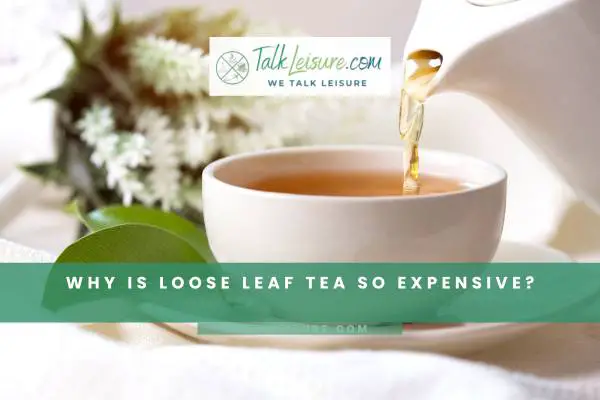
Loose-leaf tea can seem pricier than tea bags because it’s made from better-quality tea leaves.
These whole leaves or bigger pieces keep the flavor and aroma intact, giving you a tastier tea.
Making loose-leaf tea involves more careful steps and fancier packaging to keep it fresh and safe.
The bags or tins they use can be more special to protect the tea’s great taste and smell.
Even though loose-leaf tea costs more upfront, it gives you a richer tea experience that many tea lovers find worth the extra expense.
Is Loose Leaf Tea Better For The Environment?
Loose-leaf tea is generally better for the environment compared to tea bags.
Loose-leaf tea usually involves less packaging, as it’s sold in bulk or paper bags, reducing the use of single-use plastic in many tea bags.
Tea bags can contain non-biodegradable materials like nylon or polyester, which take longer to break down in the environment.
Moreover, producing tea bags often requires more energy and resources than loose-leaf tea, contributing to a higher carbon footprint.
Choosing loose-leaf tea encourages a more sustainable consumption pattern, as it reduces waste and minimizes the impact on the environment.
So, when sipping on loose-leaf tea, you’re enjoying a flavorful cup and making a positive choice for the planet.
Pros And Cons Of Loose Leaf Tea Vs. Tea Bag
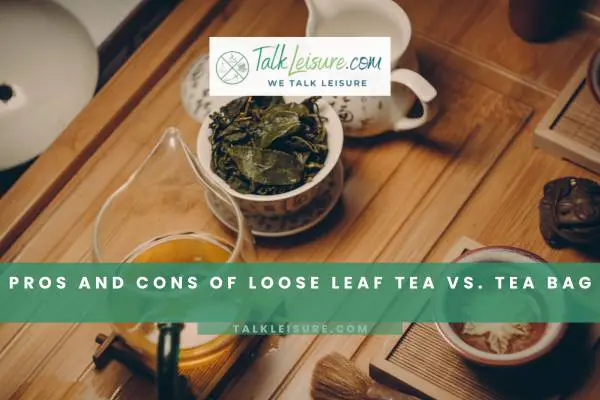
Choosing between loose-leaf tea and tea bags presents tea enthusiasts with a delightful dilemma.
Each option offers unique advantages and drawbacks, catering to various preferences and priorities.
Loose-leaf tea, celebrated for its premium quality and customizable brewing experience, beckons with the promise of fuller flavors and an aesthetic brewing process. On the other hand, tea bags, celebrated for their convenience and simplicity, provide a swift and mess-free infusion.
Exploring the pros and cons of these two popular tea forms reveals a nuanced landscape that ultimately empowers tea lovers to choose their desired tea-drinking journey.
| Aspect | Pros of Loose Leaf Tea | Cons of Loose Leaf Tea | Pros of Tea Bags | Cons of Tea Bags |
|---|---|---|---|---|
| Flavor | Richer and fresher taste | Requires additional tools for brewing | Convenient and quick to use | May lack depth of flavor |
| Quality | The brewing process can be less convenient | Quality can vary depending on the brand | Budget-friendly option | A quick and convenient option |
| Aroma | The brewing process can be time-consuming | The stronger and more fragrant aroma | Consistent flavor and strength | Aroma might be less pronounced |
| Customization | Adjustable tea quantity to personal preference | The initial investment might be higher | Portability for on-the-go situations | Limited in adjusting strength and flavor |
| Environmental Impact | Less waste due to minimal packaging | Less convenient for quick brewing | Widely available in various flavors | It may lack the depth of flavor |
| Brewing | Involving and enjoyable process | |||
| Cost | It can generate more waste due to individual packaging | |||
| Convenience | A quick and convenient option | Quick and convenient option | ||
| Portability | Easy to carry and use | Easy to carry and use |
Final Thoughts
The age-old debate surrounding loose-leaf tea versus tea bags ultimately hinges on individual preferences and priorities.
While tea bags offer convenience, loose-leaf tea opens the door to a more profound and enjoyable tea journey.
Its quality, health benefits, and sustainable practices make it a choice that resonates with those who value the taste and the tea experience.
So, whether you’re an ardent tea enthusiast or a casual tea drinker, the allure of loose-leaf tea’s superior quality is undeniable.
FAQ
How To Make Loose Leaf Tea?
Boil water and measure 1 tsp of loose tea per cup. Place the leaves in an infuser or pot, then pour hot water. Let it steep for 2-5 minutes, adjusting based on preference. Remove the leaves and, if you like, add honey or lemon for extra flavor. Savor the freshly brewed loose-leaf tea and relax.
What Are The Disadvantages Of Loose Leaf Tea?
Loose-leaf tea can be less convenient than tea bags due to the need for special equipment like infusers and potential mess during preparation. It might require more effort for steeping and cleaning. Also, loose leaf tea can be pricier per serving than some tea bags. However, these downsides are often outweighed by the superior flavor and quality loose-leaf tea offers.
Why Do My Loose Leaf Tea Taste Weak?
Your loose leaf tea might taste weak due to using too few tea leaves, not steeping long enough, improper water temperature, or low-quality tea leaves. Adjust these factors to achieve a stronger flavor: use more tea leaves, steep for a longer time, ensure proper water temperature, and opt for high-quality tea leaves.
Best Wishes!

